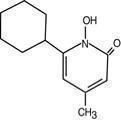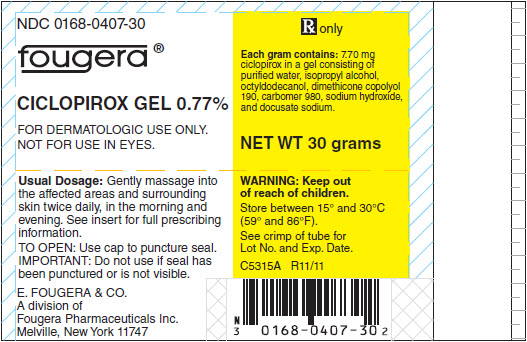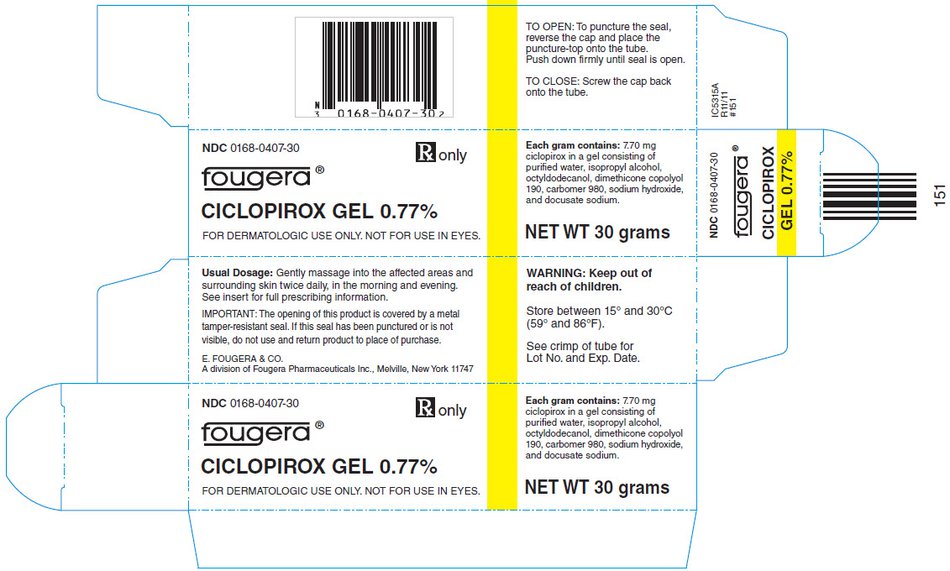Ciclopirox by E. Fougera & Co. a division of Fougera Pharmaceuticals Inc. CICLOPIROX gel
Ciclopirox by
Drug Labeling and Warnings
Ciclopirox by is a Prescription medication manufactured, distributed, or labeled by E. Fougera & Co. a division of Fougera Pharmaceuticals Inc.. Drug facts, warnings, and ingredients follow.
Drug Details [pdf]
- SPL UNCLASSIFIED SECTION
-
DESCRIPTION:
Ciclopirox Gel 0.77% contains a synthetic antifungal agent, ciclopirox. It is intended for topical dermatologic use only.
Each gram of ciclopirox gel 0.77% contains 7.70 mg of ciclopirox in a gel consisting of purified water, isopropyl alcohol, octyldodecanol, dimethicone copolyol 190, carbomer 980, sodium hydroxide, and docusate sodium.
Ciclopirox gel 0.77% is a white, slightly fluid gel.
The chemical name for ciclopirox is 6-cyclohexyl-1-hydroxy-4-methyl-2(1H)-pyridinone, with the empirical formula C12H17NO2 and a molecular weight of 207.27. The CAS Registry Number is [29342-05-0].The chemical structure is:
-
CLINICAL PHARMACOLOGY:
Mechanism of Action: Ciclopirox acts by chelation of polyvalent cations (Fe3+ or Al3+) resulting in the inhibition of the metal-dependent enzymes that are responsible for the degradation of peroxides within the fungal cell. In vitro studies showed that ciclopirox inhibited the formation of 5-lipoxygenase inflammatory mediators (5-HETE and LTB4) and also inhibited PGE2 release in a cell culture model. In vivo, ciclopirox inhibited inflammation in an arachidonic acid-induced murine ear edema model. The clinical significance of these findings is unknown.
Pharmacokinetics: A comparative study of the pharmacokinetics of ciclopirox gel and ciclopirox cream (ciclopirox olamine) 0.77% in 18 healthy males indicated that systemic absorption of ciclopirox from ciclopirox gel was higher than that of ciclopirox cream. A 5 gm dose of ciclopirox gel produced a mean (±SD) peak serum concentration of 25.02 (±20.6) ng/mL total ciclopirox and 5 gm of ciclopirox cream produced 18.62 (±13.56) ng/mL total ciclopirox. Approximately 3% of the applied ciclopirox was excreted in the urine within 48 hours after application, with a renal elimination half-life of about 5.5 hours. In a study of ciclopirox gel, 16 men with moderate to severe tinea cruris applied approximately 15 grams/day of the gel for 14.5 days. The mean (±SD) dose-normalized values of Cmax for total ciclopirox in serum were 100 (±42) ng/mL on day 1 and 238 (±144) ng/mL on Day 15. During the 10 hours after dosing on Day 1, approximately 10% of the administered dose was excreted in the urine.
Microbiology: Ciclopirox is a hydroxypyridinone antifungal agent that inhibits the growth of pathogenic dermatophytes. Ciclopirox has been shown to be active against most strains of the following microorganisms both in vitro and in clinical infections as described in the INDICATIONS AND USAGE section: Trichophyton rubrum, Trichophyton mentagrophytes, and Epidermophyton floccosum.
-
INDICATIONS AND USAGE:
Superficial Dermotophyte Infections - Ciclopirox gel 0.77% is indicated for the topical treatment of interdigital tinea pedis and tinea corporis due to Trichophyton rubrum, Trichophyton mentagrophytes, Epidermophyton floccosum. Seborrheic Dermatitis - Ciclopirox gel 0.77% is indicated for the topical treatment of seborrheic dermatitis of the scalp.
- CONTRAINDICATIONS:
- WARNINGS:
-
PRECAUTIONS:
If a reaction suggesting sensitivity or chemical irritation should occur with the use of ciclopirox gel 0.77%, treatment should be discontinued and appropriate therapy instituted. A transient burning sensation may occur, especially after application to sensitive areas. Avoid contact with eyes. Efficacy of ciclopirox gel 0.77% in immunosuppressed individuals has not been studied. Seborrheic dermatitis in association with acne, atopic dermatitis, Parkinsonism, psoriasis and rosacea has not been studied with ciclopirox gel 0.77%. Efficacy in the treatment of plantar and vesicular types of tinea pedis has not been established.
Information for Patients
The patient should be told the following:
- 1. Use ciclopirox gel 0.77% as directed by the physician. Avoid contact with the eyes and mucous membranes. Ciclopirox gel 0.77% is for external use only.
- 2. Use the medication for fungal infections for the full treatment time even though symptoms may have improved, and notify the physician if there is no improvement after four weeks.
- 3. A transient burning/stinging sensation may be felt. This may occur in approximately 15% to 20% of cases, when ciclopirox gel 0.77% is used to treat seborrheic dermatitis of the scalp.
- 4. Inform the physician if the area of application shows signs of increased irritation or possible sensitization (redness with itching, burning, blistering, swelling and/or oozing).
- 5. Avoid the use of occlusive dressings.
- 6. Do not use this medication for any disorder other than that for which it is prescribed.
Carcinogenesis, Mutagenesis, Impairment of Fertility: A carcinogenicity study of ciclopirox (1% and 5% solutions in polyethylene glycol 400) in female mice dosed cutaneously twice per week for 50 weeks followed by a 6-month drug-free observation period prior to necropsy revealed no evidence of tumors at the application site. The following battery of in vitro genotoxicity tests was conducted with ciclopirox: evaluation of gene mutation in the Ames Salmonella and E. coli assays (negative); chromosome aberration assays in V79 Chinese hamster cells, with and without metabolic activation (positive); gene mutation assays in the in the HGPRT-test with V79 Chinese hamster cells (negative); and a primary DNA damage assay (i.e., unscheduled DNA synthesis assay in A549 human cells) (negative). An in vitro cell transformation assay in BALB/c 3T3 cells was negative for cell transformation. In an in vivo Chinese hamster bone marrow cytogenetic assay, ciclopirox was negative for chromosome aberrations at 5000 mg/kg.
Pregnancy - Teratogenic effects: Pregnancy Category B. Reproduction studies of ciclopirox revealed no significant evidence of impaired fertility in rats exposed orally up to 5 mg/kg body weight (approximately 5 times the maximum recommended topical human dose based on surface area). No fetotoxicity was shown due to ciclopirox in the mouse, rat, rabbit, and monkey at oral doses up to 100, 30, 30, and 50 mg/kg body weight, respectively (approximately 37.5, 30, 44, and 77 times the maximum recommended topical human dose based on surface area). By the dermal route of administration, no fetotoxicity was shown due to ciclopirox in the rat and rabbit at doses up to 120 and 100 mg/kg body weight, respectively (approximately 121 and 147 times, respectively, the maximum recommended topical human dose based on surface area). There are no adequate or well-controlled studies of topically applied ciclopirox in pregnant women. Ciclopirox gel 0.77% should be used during pregnancy only if the potential benefit justifies the potential risk to the fetus.
-
ADVERSE REACTIONS:
In clinical trials, 140 (39%) of 359 subjects treated with ciclopirox gel 0.77% reported adverse experiences, irrespective of relationship to test materials, which resulted in 8 subjects discontinuing treatment. The most frequent experience reported was skin burning sensation upon application, which occurred in approximately 34% of seborrheic dermatitis patients and 7% of tinea pedis patients. Adverse experiences occurring between 1% to 5% were contact dermatitis and pruritus. Other reactions that occurred in less than 1% included dry skin, acne, rash, alopecia, pain upon application, eye pain, and facial edema.
-
DOSAGE AND ADMINISTRATION:
Superficial Dermotophyte Infections - Gently massage ciclopirox gel 0.77% into the affected areas and surrounding skin twice daily, in the morning and evening immediately after cleaning or washing the areas to be treated. Interdigital tinea pedis and tinea corporis should be treated for four weeks. If a patient shows no clinical improvement after four weeks of treatment, the diagnosis should be reviewed. Seborrheic Dermatitis of the Scalp -Apply ciclopirox gel 0.77% to affected scalp areas twice daily, in the morning and evening for four weeks. Clinical improvement usually occurs within the first week with continuing resolution of signs and symptoms through the fourth week of treatment. If a patient shows no clinical improvement after four weeks of treatment, the diagnosis should be reviewed.
- HOW SUPPLIED:
- PACKAGE LABEL – PRINCIPAL DISPLAY PANEL – 30 GRAM CONTAINER
- PACKAGE LABEL – PRINCIPAL DISPLAY PANEL – 30 GRAM CARTON
-
INGREDIENTS AND APPEARANCE
CICLOPIROX
ciclopirox gelProduct Information Product Type HUMAN PRESCRIPTION DRUG Item Code (Source) NDC: 0168-0407 Route of Administration TOPICAL Active Ingredient/Active Moiety Ingredient Name Basis of Strength Strength CICLOPIROX (UNII: 19W019ZDRJ) (CICLOPIROX - UNII:19W019ZDRJ) CICLOPIROX 7.70 mg in 1 g Inactive Ingredients Ingredient Name Strength WATER (UNII: 059QF0KO0R) ISOPROPYL ALCOHOL (UNII: ND2M416302) OCTYLDODECANOL (UNII: 461N1O614Y) PEG/PPG-18/18 DIMETHICONE (UNII: 9H0AO7T794) CARBOMER HOMOPOLYMER TYPE C (ALLYL PENTAERYTHRITOL CROSSLINKED) (UNII: 4Q93RCW27E) SODIUM HYDROXIDE (UNII: 55X04QC32I) DOCUSATE SODIUM (UNII: F05Q2T2JA0) Packaging # Item Code Package Description Marketing Start Date Marketing End Date 1 NDC: 0168-0407-30 30 g in 1 TUBE; Type 0: Not a Combination Product 2 NDC: 0168-0407-46 45 g in 1 TUBE; Type 0: Not a Combination Product 3 NDC: 0168-0407-99 100 g in 1 TUBE; Type 0: Not a Combination Product Marketing Information Marketing Category Application Number or Monograph Citation Marketing Start Date Marketing End Date ANDA ANDA077896 06/10/2008 Labeler - E. Fougera & Co. a division of Fougera Pharmaceuticals Inc. (043838424)
© 2025 FDA.report
This site is not affiliated with or endorsed by the FDA.


